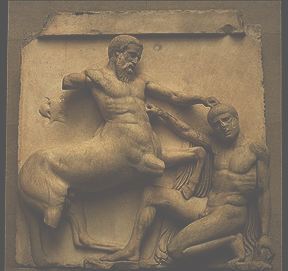Hellenic Period

Batle of Lapiths and Centaurs, Metope, Parthenon
AEGEAN: Hellenic Period
Greece, Aegean islands and colonies in Asia Minor, Italy, and Sicily. A turning point in Western Art. Geography and climate. Pantheistic religion. Secular control of state. Individual artists known. Literary refernces. Beginning of serious study in modern times with Johann Winckelmann, 1763. Classical Revival in early 19th century. Availability of stone, including marble. Use of sculpture and paint.
See The Greeks, an extraordinary PBS program on ancient Greeece.
Consult METIS, a QTVR interphase to view Greek ancient architectural sites.
CHRONOLOGY
Primitive Period ca. 1100-600 B.C.
First Olympiad 776 B.C.
Archaic Period ca. 600-400 B.C. Battle of Marathon 490 B.C.
Transitional Period ca. 480-450 B.C.
High Classic Period ca. 450-400 B.C.
Peace with Persia in 448 B.C.. Age of Pericles. 444-429 B.C.
Late Classic Period ca. 400-323 B.C.
Hellenistic Period 323-346 B.C.
THE POLIS (city)
Topography
Chorography (vs. choreography)
The organic polis (e.g, Athens) and the orthogonal polis--checkerboard, gridiron pattern--e.g, Miletus, conceived by Hippodamus.
Elements of the Polis
The concepts of incantation (repetition, e.g., triglyph, metope, triglyph...) and procession.*
*Robin Frances Rhodes, Architecture and Meaning in the Athenian Acropolis
Greek Sacred Architecture
1. The Greek concept of Space:
Pluralistic: different functions demand different kinds of space)
2. The Megaron as point of departure for the house and for the temple.
3. Sacred enclosure or precinct (temenos):
4. The Temple
Relation to wooden prototypes and forms in Egypt and the Near East. Different types of plans.
5. The Orders
Doric, Ionic, Corinthian. Composite orders.
6. Composition of the elevation of a temple:
7. The Acropolis:
8. Sanctuaries and Theatres:
Consult this site on the Greek Theatre.
Last reviewed: August 2004